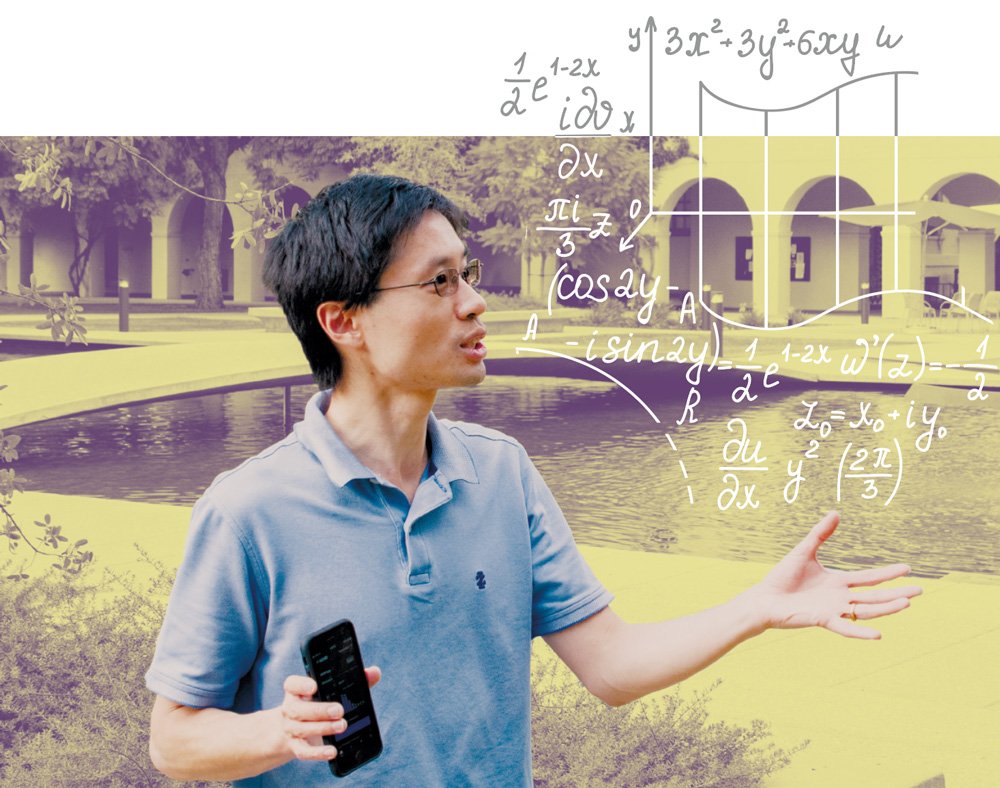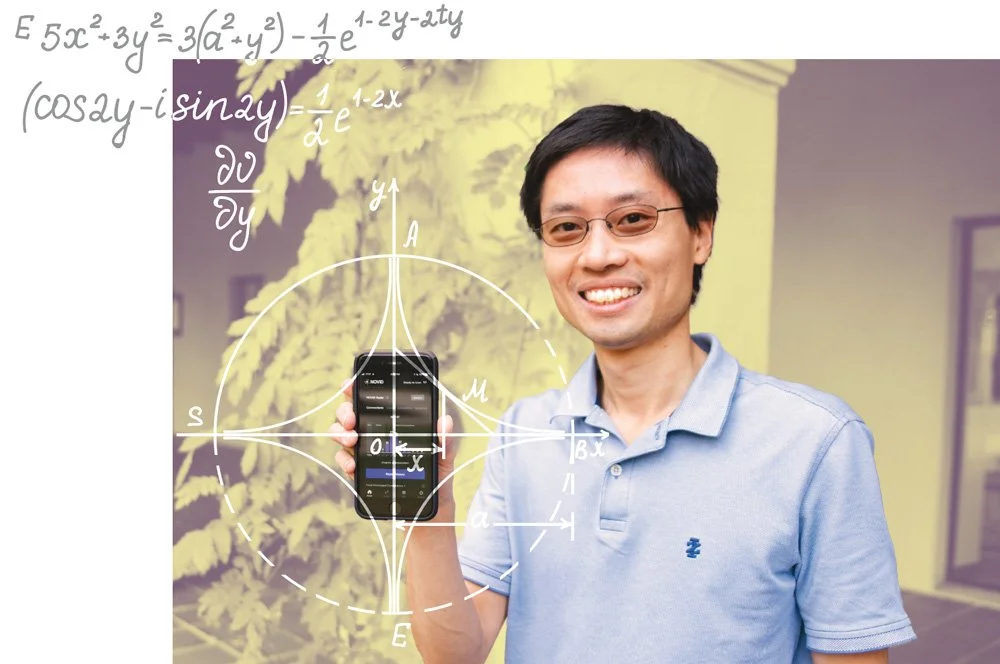Math for the Masses: Inside the Mind of Po-Shen Loh
Po-Shen Loh (BS ’04) thrives on interacting with people. Now he has created an app to keep them apart during a pandemic.
By Omar Shamout
Po-Shen Loh. Image: Dennis Lan; Shutterstock/Marina Sun
Consider it a proof of sorts. If you spend any time with mathematician Po-Shen Loh (BS ’04), you will find either that people will flock to him or that he will flock to people. This proved true on an evening in November 2021, when a throng of Caltech undergraduates became aware of his presence at the Red Door Cafe and stopped to listen in on our interview.
“I love people. I’m a people person,” says Loh, who had spoken to middle and high school students in Irvine and Monterey Park the day before his visit to Caltech. “I go all over the place because I’m trying to share ideas, and then other people share those ideas.”
A mathematics professor at Carnegie Mellon University, Loh is also the founder of the math-learning website Expii.com, the coach of the U.S. International Math Olympiad team, and a math evangelist who travels the country encouraging young students to think about math in new ways, including the method he invented to solve quadratic equations that eliminates the guess-and-check process from factorization.
“I have certain ideas of how I think things could be done better,” Loh says.
His omnipresence online as well as in person at schools and math competitions has made Loh a celebrity among math enthusiasts. When asked how they had heard of him, the Caltech undergrads could not recall how they first came across his name, only that it had seemingly always been a part of their lexicon. “It’s Professor Po-Shen Loh,” said one, implying it would be odd to suggest anyone had not heard of Loh. The Madison, Wisconsin, native sat a few feet away, smiling his signature toothy grin and wearing his trademark shorts, part of the fall-and-winter uniform he had resolved as a Caltech first-year student to wear because he could never do so in his frigid hometown.
Image: Dennis Lan; Shutterstock/Marina Sun
Applying himself
Loh is an expert in combinatorics, a field of mathematics concerned with enumeration, or counting, within discrete systems, which have a finite number of states. Combinatorics overlaps with graph theory, another of Loh’s research areas, which uses graphs made up of points to illustrate the relationship between objects or, in the case of Loh’s most recent project, people.
While his teaching philosophy is based on reaching as many individuals as possible, he is now focused on keeping them apart. In March 2020, Loh and other Hertz Foundation Fellows were encouraged in a letter from a senior member of the organization’s community to put their expertise to use in fighting the COVID-19 pandemic. (Loh was awarded a Hertz Fellowship, which recognizes “the nation’s most promising graduate students in science and technology,” in 2004.)
Hertz Fellows make a moral commitment to put their skills to work in times of national emergency even after their five years of funding are up. The day after receiving the letter, Loh was reading a PhD thesis on network theory from one of his students when its subject matter sparked a new train of thought. “I said, ‘Oh, this is the first pandemic that we’ve had smartphones,’” Loh recalls, noting that smartphones are devices that are part of a network. “I realized there’s room now to go and figure out the right way to use network theory and smartphones to help stop the virus from spreading.”
Loh decided to focus on the problem of contact tracing, and his solution, built with help from engineering and design students at Carnegie Mellon and others, is NOVID, an app that flips the traditional approach to contact tracing by helping individuals avoid infection rather than notifying them after they have been exposed. Using Bluetooth, ultrasound, and Wi-Fi technology, the app notifies a user when someone in their “network,” which is based on all recent physical interactions across the entire user population, has been infected and, most importantly, how many relationships away the infected person is from the user. (For example, a “2” would indicate that the person infected is a frequent close physical contact of a frequent close physical contact.) The idea is to tap into people’s instincts for self-preservation rather than implore them to act responsibly for the sake of others. “Every contact tracing app in the world was designed to tell you after you’ve already been around someone sick. To tell you, ‘Hey, now you’re dangerous,’” Loh explains. “We said, ‘Let’s make an app that will tell you that somebody just got sick who spends time with someone who frequently spends time with you.’ If you found that out, what would you do? Stay home.”
Loh has met with public health experts who could help NOVID be deployed by various government entities in subsequent crises.
Shifting from a focus on pure mathematics to the type of applied math involved in the creation of the NOVID app, as Loh has done, can be tricky, says David Conlon, a professor of mathematics at Caltech who also specializes in combinatorics and who first met Loh at the 1999 International Math Olympiad, where they were both competitors (Loh for the U.S. and Conlon for Ireland). The difficulty lies in applied math’s focus on hard data. “The impression is that math consists entirely of playing around with numbers, but if you’re a pure mathematician that tends not to be the case,” Conlon says. Pure math is more about theory than it is about computation and data, he notes. “But if you’re interested in tracking COVID and seeing how quickly COVID spreads, that’s a totally different thing. You really do need to do everything very quantitatively.”
Image: Dennis Lan; Shutterstock/Marina Sun
Problem child
Loh has been experimenting in areas beyond pure math since his days at Caltech, driven by a relentless desire to find solutions to difficult problems. In fact, while he majored in math, he chose to do a senior thesis, which is not required of math majors, with a computer science professor.
“It’s very rare,” says David Wales, professor of mathematics, emeritus, who served as Loh’s faculty adviser at Caltech, about Loh’s decision to pursue a thesis at all, let alone in a subject outside his area of focus. “It’s pretty amazing. It’s an indication that he was really learning a lot in his major, but he had other things that he was interested in doing as well.”
Loh not only delved into computer science academically while at Caltech but also competed on the three-person team that represented the Institute at the 2004 Association for Computing Machinery’s International Collegiate Programming Contest in Prague in which he and his teammates placed seventh out of 3,150 teams from 75 different countries.
Why did Loh spend so much time on projects outside of math? He says that, in part, he was inspired by the creativity and ingenuity of the people around him. For example, Loh recalls the time one of his Caltech roommates planned to turn an ordinary bicycle into an electric-powered one. “People just did funny things,” Loh says. “You had this feeling that, as a Caltech student, if there was an interesting, difficult, and quirky thing to do, you did it.”
Loh’s list of awards and honors during his time at Caltech is impressive by any measure. He won a Barry Goldwater Scholarship in 2003. He graduated top of his class in 2004. In addition to the Hertz fellowship, Loh received a Churchill Scholarship to study mathematics at the Graduate Research Fellowship; and a National Defense Science and Engineering Graduate Fellowship. After completing his master’s degree at Cambridge in 2005, he received his PhD from Princeton University in 2010. Caltech also became a family affair for the Lohs. His brother Po-Ru (BS ’07) and sister Po-Ling (BS ’09) are alumni as well, and he met his wife Debbie Lee (BS ’04) on the first day of orientation.
Loh’s years at the Institute helped him learn how to juggle a number of different projects at the same time. But his passion for figuring out new approaches to tough problems was born much earlier. When Loh was 11, his father, a professor of statistics at the University of Wisconsin, gave him a book of math puzzles that included a challenge to make four triangles out of six matchsticks. “The answer is to make it 3-D,” Loh says, recalling the problem that switched on that particular part of his brain. Since then, he has always tried to add new dimensions to his thinking. “If it is hard, and I think I might be able to do it, I’m going to try.”



